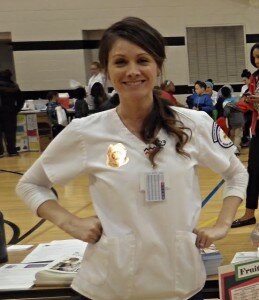
Dr Angela Pannier explains a new model for vaccines that would eliminate the use of syringes, thus eliminating a potential source of transmission of disease through unsafe injections.
Each year, 20 million Hepatitis B cases (30% of all new infections), 2 million Hepatitis C cases (40% of all new infections) and 2,500 HIV cases (5% of all new infections) occur because of unsafe injections globally. These unsafe injections are often caused because of poor injection practices throughout the world (especially in underdeveloped countries), including lack of education (i.e. trained medical personnel) and lack of appropriate storage conditions (i.e. refrigeration or freezer). Conditions throughout the world often do not allow for proper medical waste disposal, which in turn can further allow for possible misuse or reuse of syringes. Therefore, there is a significant need to eliminate unnecessary injections globally and find alternative delivery strategies. However, vaccinations, for a variety of reasons, are most effectively administered through injection.
Vaccination is considered to be one of the most successful public health interventions of the modern era, leading to a dramatic increase in life expectancy and complete eradication of smallpox worldwide. Further development of vaccines and immunization programs have led to the control of numerous infectious diseases including diphtheria, tetanus, pertussis, measles, mumps, and rubella. However, effective vaccination strategies are lacking for a number of pathogens of global health importance (e.g. rotavirus, malaria, HIV, and Toxoplasma among others). In addition, rapid emergence of new infectious disease pandemics, such as pandemic influenza A virus and Ebola, demonstrates the urgent need for vaccine platforms that quickly move from disease identification to vaccines.
Traditional vaccines use weakened or dead bacteria or viruses to stimulate an immune reaction and are administered through injection (or nasal spray) because the bacteria or viruses cannot elicit a protective response if given any other way (e.g. bacteria or virus become damaged if consumed orally or do not reach their intended targeted if given transdermally). Furthermore, current vaccines cannot survive without refrigeration, which limits their use in less developed countries, a health concern in its own right.
Our multidisciplinary team at the University of Nebraska is developing a new model for vaccines that would eliminate the use of syringes. Rather than using weakened or dead bacteria or viruses to stimulate an immune reaction, we propose using genetic material (i.e. DNA) to prompt an immune response, which could allow for oral delivery. This new vaccine model would contain a replica of encoded genetic material from a virus or bacteria. DNA is extremely stable and can be stored on the shelf, thus eliminating the need for cold storage that prevents worldwide administration of vaccines. DNA can also be created in the lab very quickly, allowing for response to pandemics within a matter of weeks. Our team is especially focused on the development of polymers to protect these DNA vaccines so that they could be delivered orally via pill form. Along with eliminating the need for syringes, this would greatly expedite global distribution.
For these pills we are using two natural, safe polymers, chitosan and zein, the former found in the exoskeleton of crustaceans and the latter one made from a biodegradable protein from corn currently used in food and drug manufacturing. Due to this unique combination of materials, we propose that the DNA vaccine can be taken orally and protected as it moves through the digestive system. Once it reaches the intestine, the genetic material can be absorbed by the body, prompt an immune reaction, and build up future immunity. Vaccines based on this model are already used in veterinary medicine but in injection form. We believe that with our proposed system, we will have safer, faster, and easier vaccines for humans that eliminate the possibility of unsafe injections and the use of syringes entirely.
Dr. Angela K. Pannier is a Biomedical Engineer, Associate Professor, and William E. Brooks Engineering Leadership Fellow in the Department of Biological Systems Engineering at the University of Nebraska-Lincoln. She also holds a courtesy appointment in the Department of Surgery and the Mary and Dick Holland Regenerative Medicine Program at the University of Nebraska Medical Center.
Dr. Pannier’s collaborators on the research described above are: Dr. Tadeusz Wysocki, Professor of Computer and Electronics Engineering, University of Nebraska-Lincoln; Dr. Amanda Ramer-Tait, Assistant Professor of Food Science and Technology, University of Nebraska-Lincoln; Dr. Deborah Brown, Associate Professor, School of Biological Sciences, University of Nebraska-Lincoln; and Dr. Paul Davis, Assistant Professor of Biology, University of Nebraska at Omaha.






